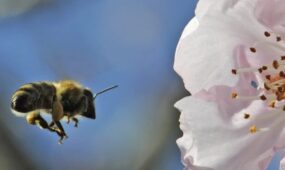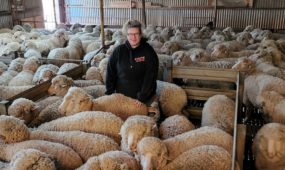Through the eyes of a natural born killer
Primary Industries
VIDEO cameras and GPS collars are being attached to feral cats to monitor their behaviour as a new virus decimates the rabbit population in Outback Australia.

Sign up to receive notifications about new stories in this category.
Thank you for subscribing to story notifications.
Leading Australian feral cat researcher Hugh McGregor is studying the movement and hunting patterns of feral cats at Arid Recovery near Roxby Downs in South Australia.
Situated about 600km north of the South Australian capital Adelaide, Arid Recovery is a 123sq km fenced reserve divided into seven controlled research areas. Dr McGregor’s study is focused on a 37sq km area containing feral cats, rabbits and native reptiles and mammals.
Threatened mammals in other sections of the reserve include the Greater Bilby, Western Barred Bandicoot, Burrowing Bettong and the Spinifex Hopping Mouse.
The study coincides with the onset of a deadly rabbit calicivirus, RHDV2, which is sweeping across South Australia and may wipe out a significant proportion of the rabbit population, another introduced species to Australia that damages ecosystems.
Dr McGregor said the study would look at how the reduction in rabbit numbers affected the behaviour and the numbers of feral cats.
He said, based on scats and stomach contents, the diet of feral cats consisted of about 30 per cent rabbit and 70 per cent native animals such as small mammals and reptiles.
“We want to look to see whether the cats are hunting more native animals – and that’s where we’re using little video cameras,” Dr McGregor said.
“We’ll do that while there’s still rabbits around to see their hunting rates and kill rates and we’ll continue to do that after the rabbit population crashes.
“We’ll also be able to see whether the cats get more desperate by travelling further in the hunt for food and hunting bigger prey such as bearded dragons and goannas.”
The “Prey Switching” project started last month and will continue until mid-2017. Early video footage and GPS data show rabbits form a significant part of the feral cats’ diets.
“They are spending most of their days at the moment focusing on rabbit warrens,” Dr McGregor said.
“We haven’t recorded many native animals being attacked yet but we know they are still killing native animals in the area because they are turning up in the scats but they are certainly doing what we predicted and that is really hammering the rabbit population.
“It will be very interesting to see what’s going to happen once the rabbits are taken away from them.”
Dr McGregor said the video footage gave researchers an insight into the minds and daily habits of feral cats.
Australian Wildlife Coservancy puts the total population of feral cats in Australia at approximately 4 million and says each cat kills between 5 and 30 animals per day.
Feral cats have directly contributed to the extinction of more than 20 mammals since arriving in Australia with the first European settlers in the late 18th Century. They now pose a threat to about a third of Australia’s threatened mammals, reptiles, frogs and birds.
The rabbit problem on mainland Australia dates back to the release of 24 wild rabbits for hunting purposes in Victoria in 1859.
By 1920 it is thought there were 10 billion rabbits in Australia making it the fastest spread ever recorded of a mammal species anywhere in the world.
Following the success of biological rabbit controls, including the release of the myxoma virus in 1950 and the first calicivirus (RHDV) in the mid-1990s, rabbit numbers have been significantly reduced. The population is still estimated to be about 200 million, costing Australian agricultural industries more than $200 million every year.
Dr McGregor said the reduction in rabbit numbers would likely also lead to a drop in feral cat and fox numbers, as it did when the initial calicivirus devastated the rabbit population in the 1990s.
“It’s like the calicivirus is an extremely effective cat control agent as well as a rabbit control agent,” he said.
“We’re hoping to compare the drop in cat density after the calicivirus with the increase in native animals – I’m going to suspect that they are going to start killing native animals to a greater extent but the density of cats is going to drop right off.
“Even though every cat might be eating 30 per cent more native animals, there could be a 50 – 80 per cent drop in cat density so overall I’m expecting a drop in the impact on native animals.”
Feral cats usually only eat some of the animals they kill and rarely take baits because of their preference for live prey.
Dr McGregor has been putting out non-poison meat baits as part of his project to see at what moment the cats become hungry enough to start taking baits.
“If we could pick those times it would also help do cat control over huge areas as well by using poison baits,” he said.
“It could well be more effective than any shooting program or any trapping program ever could be.”
The RHDV2 calicivirus from France was found in wild rabbits in the Australian Capital Territory in May 2015 and has since spread across New South Wales, Victoria and much of South Australia.
A new virus from Korea, RHDV1 K5, will be released in every Australian state in 2017 to target rabbits immune to previous strains.
Biosecurity SA Senior Research Officer Greg Mutze said it was so far difficult to predict the impact of RHDV2 or the impact it could have on the success of the RHDV1 K5 roll out next year.
He said his department was in touch with Dr McGregor and would follow the results of his study with interest.
“Cats are a major problem nationally so all of these projects are adding pieces of information to try and complete the picture of what we know about them,” Mutze said.
Jump to next article



